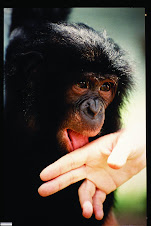 This is tanapox, photographed in Zaire, now the Democratic Republic of the Congo. While sampling animals for monkeypox virus, I also collected mosquitoes along the banks of the Zaire River in the town of Lisala, where tanapox was seen. The theory was that the tanapox reservoir rested in small mammals (possibly monkeys) and mosquitoes were the vectors.
This is tanapox, photographed in Zaire, now the Democratic Republic of the Congo. While sampling animals for monkeypox virus, I also collected mosquitoes along the banks of the Zaire River in the town of Lisala, where tanapox was seen. The theory was that the tanapox reservoir rested in small mammals (possibly monkeys) and mosquitoes were the vectors.Tanapox was first described in the late '50s along the Tana River in Kenya, where several hundred people were afflicted. It is found throughout tropical Africa, but is rarely seen. The virus can be cultured only in monkey and human tissue. A near identical disease is found in laboratory monkeys.
Like monkeypox, tanapox is a zoonosis, meaning that it is transmitted from an animal host. It is a double-stranded DNA poxvirus that starts with a fever, followed by a single hard nodule, usually on the extremities. Sometimes there are a few lesions, with a maximum of a dozen. Fortunately, patient recovery and resolution of the lesion(s) is the outcome. Tanapox occurs in males and females, of all ages and is not readily transmitted between people.
Only five cases of tanapox have been seen in the United States. Three of these came from contact with a laboratory animal, and one was a traveler from Sierra Leone. The most recent case was a 21 year-old college student who cared for orphaned chimpanzees for two months at a sanctuary in the Republic of the Congo. She exhibited a fever, swollen lymph glands and a lesion on an elbow and leg. She was first treated for malaria and then a local doctor attempted to aspirate material from a nodule, but it was solid.
Two weeks later, she returned to the states, where tanapox was suggested as a tentative diagnosis, which was confirmed by polymerase-chain-reaction (PCR).
Photo by World Health Organization





























